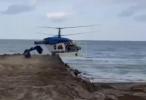רוסישע באאמטע זענען געשטארבן ווען זייער פליגער האט געקראכט


A helicopter crash in Russia’s southern region of Dagestan has dealt a serious blow to the country’s defense production network. The Ka-226 aircraft, operated by the Kizlyar Electromechanical Plant—a facility sanctioned by both the United States and the European Union—went down near the Caspian Sea in the Karabudakhkent district on November 7, 2025. Initial reports indicate the helicopter suffered a hard landing that damaged its tail boom. When the pilot attempted to lift off again, the aircraft lost stability and crashed, bursting into flames shortly after impact.
The crash killed four senior members of the plant’s leadership team, including Deputy General Director Akhmat Akhmatov, the chief engineer, and the chief designer—key figures responsible for the development of avionics systems used in Russia’s Sukhoi and MiG fighter jets. Both pilots survived but sustained serious injuries and were transported to a local hospital.
The Kizlyar Electromechanical Plant has long been a critical node in Russia’s military-industrial complex, manufacturing components essential for aircraft deployed in Moscow’s ongoing war against Ukraine. Western sanctions have targeted the factory for enabling the Kremlin’s war machine, cutting off access to foreign parts and financial systems. The sudden loss of its top engineering leadership now raises questions about the continuity of production and Russia’s ability to maintain its fighter jet fleet amid mounting battlefield losses and supply shortages.
Analysts note that this accident could have far-reaching effects on Russia’s defense capabilities. The dead executives were central to coordinating production lines and designing advanced avionics systems tailored for modernized aircraft. Their deaths not only weaken the factory’s technical command but also expose the fragility of a military infrastructure increasingly isolated from global markets.
While Moscow’s official channels have yet to release detailed findings, sources within Russian media have described the event as a “tragic loss.” However, the timing is significant: the crash comes as Russian forces face intensified Ukrainian counterstrikes and as Western nations increase pressure on defense suppliers through expanded sanctions. This latest blow underscores the growing strain on Russia’s military manufacturing network—a system now struggling to sustain the Kremlin’s war ambitions under international isolation and internal setbacks.
גאלערי
ווידעאס